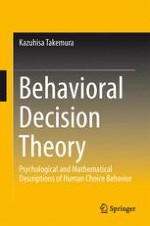2014 | OriginalPaper | Chapter
13. Behavioral Decision Theory and Good Decision Making
Author : Professor Kazuhisa Takemura
Published in: Behavioral Decision Theory
Publisher: Springer Japan
Activate our intelligent search to find suitable subject content or patents.
Select sections of text to find matching patents with Artificial Intelligence. powered by
Select sections of text to find additional relevant content using AI-assisted search. powered by
